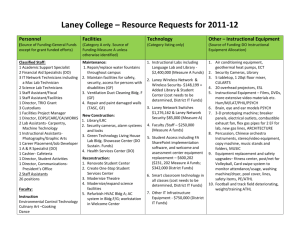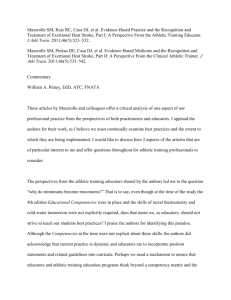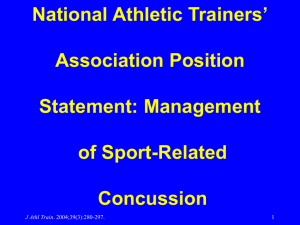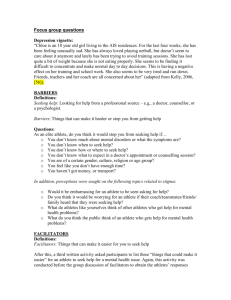J Athl Train. - National Athletic Trainers' Association
advertisement
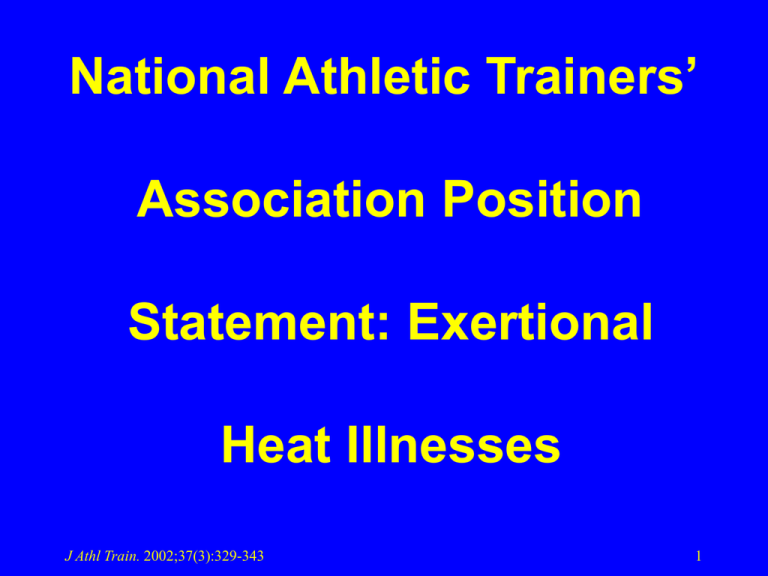
National Athletic Trainers’ Association Position Statement: Exertional Heat Illnesses J Athl Train. 2002;37(3):329-343 1 Helen M. Binkley*; Joseph Beckett†; Douglas J. Casa‡; Douglas M. Kleiner§; Paul E. PlummerⅡ *Mesa State College, Grand Junction, CO; †University of Charleston, Charleston, WV; ‡University of Connecticut, Storrs, CT; §University of Florida, Jacksonville, FL; ⅡIndiana State University, Terre Haute, IN J Athl Train. 2002;37(3):329-343 2 Recommendations J Athl Train. 2002;37(3):329-343 3 Prevention J Athl Train. 2002;37(3):329-343 4 1. Ensure that appropriate medical care is available and that rescue personnel are familiar with exertional heat illness prevention, recognition, and treatment. Table 2 provides general guidelines that should be considered. Ensure… J Athl Train. 2002;37(3):329-343 5 1. (continued) …that ATCs and other health care providers attending practices or events are allowed to evaluate and examine any athlete who displays signs or symptoms of heat illness and have the authority to restrict the athlete from participating if heat illness is present. J Athl Train. 2002;37(3):329-343 6 2. Conduct a thorough, physiciansupervised, preparticipation medical screening before the season starts to identify athletes predisposed to heat illness on the basis of risk factors and those who have a history of exertional heat illness. J Athl Train. 2002;37(3):329-343 7 3. Adapt athletes to exercise in the heat (acclimatization) gradually over 10 to 14 days. Progressively increase the intensity and duration of work in the heat with a combination of strenuous interval training… J Athl Train. 2002;37(3):329-343 8 3. (continued) …and continuous exercise. Wellacclimatized athletes should train for 1 to 2 hours under the same heat conditions that will be present for their event. In a cooler environment, an athlete can wear additional clothing during training to induce… J Athl Train. 2002;37(3):329-343 9 3. (continued) …or maintain heat acclimatization. Athletes should maintain proper hydration during the heatacclimatization process. J Athl Train. 2002;37(3):329-343 10 4. Educate athletes and coaches regarding the prevention, recognition, and treatment of heat illnesses9and the risks associated with exercising in hot, humid environmental conditions. J Athl Train. 2002;37(3):329-343 11 5. Educate athletes to match fluid intake with sweat and urine losses to maintain adequate hydration. (See the “National Athletic Trainers' Association Position Statement: Fluid Replacement in Athletes.”) Instruct athletes to drink… J Athl Train. 2002;37(3):329-343 12 5. (continued) …sodium-containing fluids to keep their urine clear to light yellow to improve hydration and to replace fluids between practices on the same day and on successive days to maintain less than 2% body-weight change. These strategies will… J Athl Train. 2002;37(3):329-343 13 5. (continued) …lessen the risk of acute and chronic dehydration and decrease the risk of heat-related events. J Athl Train. 2002;37(3):329-343 14 6. Encourage athletes to sleep at least 6 to 8 hours at night in a cool environment, eat a well-balanced diet that follows the Food Guide Pyramid and United States Dietary Guidelines, and maintain proper hydration… J Athl Train. 2002;37(3):329-343 15 6. (continued) … status. Athletes exercising in hot conditions (especially during twicea-day practices) require extra sodium from the diet or rehydration beverages or both. J Athl Train. 2002;37(3):329-343 16 7. Develop event and practice guidelines for hot, humid weather that anticipate potential problems encountered based on the wet-bulb globe temperature (WBGT) (Table 3) or heat and humidity as measured by a sling psychrometer (Figure 1), the number of participants,… J Athl Train. 2002;37(3):329-343 17 7. (continued) …the nature of the activity, and other predisposing risk factors. If the WBGT is greater than 28°C (82°F, or “very high” as indicated in Table 3, Figure 1), an athletic event should be… J Athl Train. 2002;37(3):329-343 18 7. (continued) …delayed, rescheduled, or moved into an air-conditioned space, if possible. It is important to note that these measures are based on the risk of environmental stress for athletes wearing shorts and… J Athl Train. 2002;37(3):329-343 19 7. (continued) …a T-shirt; if an athlete is wearing additional clothing (ie, football uniform, wetsuit, helmet), a lower WBGT value could result in comparable risk of environmental heat stress (Figure 2). If the event… J Athl Train. 2002;37(3):329-343 20 7. (continued) …or practice is conducted in hot, humid conditions, then use extreme caution in monitoring the athletes and be proactive in taking preventive steps. In addition, be sure that emergency supplies and equipment are easily accessible and… J Athl Train. 2002;37(3):329-343 21 7. (continued) …in good working order. The most important factors are to limit intensity and duration of activity, limit the amount of clothing and equipment worn, increase the number and length of rest breaks, and encourage proper hydration.… J Athl Train. 2002;37(3):329-343 22 7. (continued) …Modify activity under high-risk conditions to prevent exertional heat illnesses. Identify individuals who are susceptible to heat illnesses. In some athletes, the prodromal signs and symptoms of heat illnesses are not evident before collapse, but in… J Athl Train. 2002;37(3):329-343 23 7. (continued) … many cases, adept medical supervision will allow early intervention. J Athl Train. 2002;37(3):329-343 24 8. Check the environmental conditions before and during the activity, and adjust the practice schedule accordingly. Schedule training sessions to avoid the hottest part of the day (10 AM to 5 PM) and to avoid radiant heating from direct sunlight, especially in the… J Athl Train. 2002;37(3):329-343 25 8. (continued) … acclimatization during the first few days of practice sessions. J Athl Train. 2002;37(3):329-343 26 9. Plan rest breaks to match the environmental conditions and the intensity of the activity. Exercise intensity and environmental conditions should be the major determinants in deciding the length and frequency of rest breaks. If possible,… J Athl Train. 2002;37(3):329-343 27 9. (continued) …cancel or postpone the activity or move it indoors (if air conditioned) if the conditions are “extreme or hazardous” (see Table 3) or “very high” (see Figure 1) or to the right of the circled line (see Figure 2). General guidelines during… J Athl Train. 2002;37(3):329-343 28 9. (continued) …intense exercise would include a work:rest ratio of 1:1, 2:1, 3:1, and 4:1 for “extreme or hazardous” (see Table 3) or “very high” (see Figure 1), “high,” “moderate,” or “low” environmental risk, respectively. For activities… J Athl Train. 2002;37(3):329-343 29 9. (continued) …such as football in which equipment must be considered, please refer to Figure 2 for equipment modifications and appropriate work:rest ratios for various environmental… J Athl Train. 2002;37(3):329-343 30 9. (continued) …conditions. Rest breaks should occur in the shade if possible, and hydration during rest breaks should be encouraged. J Athl Train. 2002;37(3):329-343 31 10. Implement rest periods at mealtime by allowing 2 to 3 hours for food, fluids, nutrients, and electrolytes (sodium and potassium) to move into the small intestine and bloodstream before the next practice. J Athl Train. 2002;37(3):329-343 32 11. Provide an adequate supply of proper fluids (water or sports drinks) to maintain hydration and institute a hydration protocol that allows the maintenance of hydration status. Fluids should be readily available and… J Athl Train. 2002;37(3):329-343 33 11. (continued) …served in containers that allow adequate volumes to be ingested with ease and with minimal interruption of exercise. The goal should be to lose no more than 2% to 3% of body weight… J Athl Train. 2002;37(3):329-343 34 11. (continued) …during the practice session (due to sweat and urine losses). (See the “National Athletic Trainers' Association Position Statement: Fluid Replacement in Athletes.”) J Athl Train. 2002;37(3):329-343 35 12. Weigh high-risk athletes (in high-risk conditions, weigh all athletes) before and after practice to estimate the amount of body water lost during practice and to ensure a return to prepractice weight… J Athl Train. 2002;37(3):329-343 36 12. (continued) …before the next practice. Following exercise, athletes should consume approximately 1–1.25 L (34-50 oz) of fluid for each kilogram of body water lost during exercise. J Athl Train. 2002;37(3):329-343 37 13. Minimize the amount of equipment and clothing worn by the athlete in hot or humid (or both) conditions. For example, a full football uniform prevents sweat evaporation from more than 60% of the body. Consult Figure 2… J Athl Train. 2002;37(3):329-343 38 13. (continued) …for possible equipment and clothing recommendations. When athletes exercise in the heat, they should wear loose-fitting, absorbent, and light-colored clothing; mesh clothing… J Athl Train. 2002;37(3):329-343 39 13. (continued) …and new-generation cloth blends have been specially designed to allow more effective cooling. J Athl Train. 2002;37(3):329-343 40 14. Minimize warm-up time when feasible, and conduct warm-up sessions in the shade when possible to minimize the radiant heat load in “high” or “very high” or “extreme or hazardous” (see Table 3, Figure 1) conditions. J Athl Train. 2002;37(3):329-343 41 15. Allow athletes to practice in shaded areas and use electric or cooling fans to circulate air whenever feasible. J Athl Train. 2002;37(3):329-343 42 16. Include the following supplies on the field, in the locker room, and at various other stations: J Athl Train. 2002;37(3):329-343 43 • A supply of cool water or sports drinks or both to meet the participants' needs (see the “National Athletic Trainers' Association Position Statement: Fluid Replacement in Athletes” for recommendations regarding the appropriate composition… J Athl Train. 2002;37(3):329-343 44 … of rehydration beverages based on the length and intensity of the activity) • Ice for active cooling (ice bags, tub cooling) and to keep beverages cool during exercise J Athl Train. 2002;37(3):329-343 45 • Rectal thermometer to assess body-core temperature • Telephone or 2-way radio to communicate with medical personnel and to summon emergency medical transportation J Athl Train. 2002;37(3):329-343 46 • Tub, wading pool, kiddy pool, or whirlpool to cool the trunk and extremities for immersion cooling therapy J Athl Train. 2002;37(3):329-343 47 17. Notify local hospital and emergency personnel before mass participation events to inform them of the event and the increased possibility of heat-related illnesses. J Athl Train. 2002;37(3):329-343 48 18. Mandate a check of hydration status at weigh-in to ensure athletes in sports requiring weight classes (eg, wrestling, judo, rowing) are not dehydrated. Any procedures used to induce dramatic… J Athl Train. 2002;37(3):329-343 49 18. (continued) …dehydration (eg, diuretics, rubber suits, exercising in a sauna) are strictly prohibited. Dehydrated athletes exercising at the same intensity as euhydrated athletes are at increased risk for… J Athl Train. 2002;37(3):329-343 50 18. (continued) …thermoregulatory strain (see the “National Athletic Trainers' Association Position Statement: Fluid Replacement in Athletes”). J Athl Train. 2002;37(3):329-343 51 Recognition and Treatment J Athl Train. 2002;37(3):329-343 52 19. Exercise-associated muscle (heat) cramps: J Athl Train. 2002;37(3):329-343 53 • An athlete showing signs or symptoms including dehydration, thirst, sweating, transient muscle cramps, and fatigue is likely experiencing exercise-associated muscle (heat) cramps. J Athl Train. 2002;37(3):329-343 54 • To relieve muscle spasms, the athlete should stop activity, replace lost fluids with sodium-containing fluids, and begin mild stretching with massage of the muscle spasm. J Athl Train. 2002;37(3):329-343 55 • Fluid absorption is enhanced with sports drinks that contain sodium. A high-sodium sports product may be added to the rehydration beverage to prevent or relieve cramping in athletes who lose large amounts of sodium in their sweat. A simple salted fluid… J Athl Train. 2002;37(3):329-343 56 …consists of two 10-grain salt tablets dissolved in 1 L (34 oz) of water. Intravenous fluids may be required if nausea or vomiting limits oral fluid intake; these must be ordered by a physician. J Athl Train. 2002;37(3):329-343 57 • A recumbent position may allow more rapid redistribution of blood flow to cramping leg muscles. J Athl Train. 2002;37(3):329-343 58 20. Heat syncope: J Athl Train. 2002;37(3):329-343 59 • If an athlete experiences a brief episode of fainting associated with dizziness, tunnel vision, pale or sweaty skin, and a decreased pulse rate but has a normal rectal temperature (for exercise, 36°C to 40°C [97°F to 104°F]), then heat syncope is most likely the cause. J Athl Train. 2002;37(3):329-343 60 • Move the athlete to a shaded area, monitor vital signs, elevate the legs above the level of the head, and rehydrate. J Athl Train. 2002;37(3):329-343 61 21. Exercise (heat) exhaustion: J Athl Train. 2002;37(3):329-343 62 • Cognitive changes are usually minimal, but assess central nervous system function for bizarre behavior, hallucinations, altered mental status, confusion, disorientation, or coma (see Table 1) to rule out more serious conditions. J Athl Train. 2002;37(3):329-343 63 • If feasible, measure body-core temperature (rectal temperature) and assess cognitive function (see Table 1) and vital signs. Rectal temperature is the most accurate method possible in the field to monitor body-core temperature. The ATC should... J Athl Train. 2002;37(3):329-343 64 not rely on the oral, tympanic, or axillary temperature for athletes because these are inaccurate and ineffective measures of body-core temperature during and after exercise. J Athl Train. 2002;37(3):329-343 65 • If the athlete's temperature is elevated, remove his or her excess clothing to increase the evaporative surface and to facilitate cooling. J Athl Train. 2002;37(3):329-343 66 • Cool the athlete with fans, ice towels, or ice bags because these may help the athlete with a temperature of more than 38.8°C (102°F) to feel better faster. J Athl Train. 2002;37(3):329-343 67 • Remove the athlete to a cool or shaded environment if possible. • Start fluid replacement. J Athl Train. 2002;37(3):329-343 68 • Transfer care to a physician if intravenous fluids are needed or if recovery is not rapid and uneventful. J Athl Train. 2002;37(3):329-343 69 22. Exertional heat stroke: J Athl Train. 2002;37(3):329-343 70 • Measure the rectal temperature if feasible to differentiate between heat exhaustion and heat stroke. With heat stroke, rectal temperature is elevated (generally higher than 40°C [104°F]). J Athl Train. 2002;37(3):329-343 71 • Assess cognitive function, which is markedly altered in exertional heat stroke (see Table 1). J Athl Train. 2002;37(3):329-343 72 • Lower the body-core temperature as quickly as possible. The fastest way to decrease body temperature is to remove clothes and equipment and immerse the body (trunk and extremities) into a pool or tub… J Athl Train. 2002;37(3):329-343 73 • …of cold water (approximately 1°C to 15°C [35°F to 59°F]). Aggressive cooling is the most critical factor in the treatment of exertional heat stroke. Circulation of the tub water may enhance cooling. J Athl Train. 2002;37(3):329-343 74 • Monitor the temperature during the cooling therapy and recovery (every 5 to 10 minutes). Once the athlete's rectal temperature reaches approximately 38.3°C to 38.9°C (101°F to 102°F), he or she should be removed from the pool or tub to avoid overcooling. J Athl Train. 2002;37(3):329-343 75 • If a physician is present to manage the athlete's medical care on site, then initial transportation to a medical facility may not be necessary so immersion can continue uninterrupted. If a physician is not present,… J Athl Train. 2002;37(3):329-343 76 • …aggressive first-aid cooling should be initiated on site and continued during emergency medical system transport and at the hospital until the athlete is normothermic. J Athl Train. 2002;37(3):329-343 77 • Activate the emergency medical system. • Monitor the athlete's vital signs and other signs and symptoms of heat stroke (see Table 1). J Athl Train. 2002;37(3):329-343 78 • During transport and when immersion is not feasible, other methods can be used to reduce body temperature: removing the clothing; sponging down the athlete with cool water and applying cold towels; applying ice… J Athl Train. 2002;37(3):329-343 79 • …bags to as much of the body as possible, especially the major vessels in the armpit, groin, and neck; providing shade; and fanning the body with air. J Athl Train. 2002;37(3):329-343 80 • In addition to cooling therapies, first-aid emergency procedures for heat stroke may include airway management. Also a physician may decide to begin intravenous fluid replacement. J Athl Train. 2002;37(3):329-343 81 • Monitor for organ-system complications for at least 24 hours. J Athl Train. 2002;37(3):329-343 82 23. Exertional hyponatremia: J Athl Train. 2002;37(3):329-343 83 • Attempt to differentiate between hyponatremia and heat exhaustion. Hyponatremia is characterized by increasing headache, significant mental compromise, altered consciousness, seizures,… J Athl Train. 2002;37(3):329-343 84 • …lethargy, and swelling in the extremities. The athlete may be dehydrated, normally hydrated, or overhydrated. J Athl Train. 2002;37(3):329-343 85 • Attempt to differentiate between hyponatremia and heat stroke. In hyponatremia, hyperthermia is likely to be less (rectal temperature less than 40°C [104°F]. The plasma-sodium level is less than… J Athl Train. 2002;37(3):329-343 86 …130 mEq/L and can be measured with a sodium analyzer on site if the device is available. J Athl Train. 2002;37(3):329-343 87 • If hyponatremia is suspected, immediate transfer to an emergency medical center via the emergency medical system is indicated. An intravenous line should be placed to administer medication as needed to… J Athl Train. 2002;37(3):329-343 88 …increase sodium levels, induce diuresis, and control seizures. • An athlete with suspected hyponatremia should not be administered fluids until a physician is consulted. J Athl Train. 2002;37(3):329-343 89 24. Return to activity J Athl Train. 2002;37(3):329-343 90 • In cases of exercise-associated muscle (heat) cramps or heat syncope, the ATC should discuss the athlete's case with the supervising physician. The cases of athletes with heat exhaustion who… J Athl Train. 2002;37(3):329-343 91 …were not transferred to the physician's care should also be discussed with the physician. After exertional heat stroke or exertional hyponatremia, … J Athl Train. 2002;37(3):329-343 92 …the athlete must be cleared by a physician before returning to athletic participation. The return to full activity should be gradual and monitored. J Athl Train. 2002;37(3):329-343 93 Table 1. Signs and Symptoms of Exertional Heat Illnesses Condition Sign or Symptom* Exercise-associated muscle (heat) cramps) Dehydration Thirst Sweating Transient muscle cramps Fatigue *Not every patient will present with all the signs and symptoms for the suspected condition. J Athl Train. 2002;37(3):329-343 94 Table 1. (continued) Condition Sign or Symptom* Exercise (heat) exhaustion Normal or body-core temperature Dehydration Dizziness Lightheadedness Syncope Headache Nausea *Not every patient will present with all the signs and symptoms for the suspected condition. J Athl Train. 2002;37(3):329-343 95 Table 1. (continued) Condition Sign or Symptom* Exercise (heat) exhaustion (continued) Anorexia Chills Diarrhea Cool, clammy skin Urine output Intestinal cramps Persistent muscle Urge to defecate cramps Weakness Pallor Hyperventilation Profuse sweating *Not every patient will present with all the signs and symptoms for the suspected condition. J Athl Train. 2002;37(3):329-343 96 Table 1. (continued) Condition Sign or Symptom* Exertional heat stroke High body-core temperature (>40C [104F]) Central nervous system changes Dizziness Irritability Drowsiness Emotional instability Irrational behavior Hysteria Confusion Apathy *Not every patient will present with all the signs and symptoms for the suspected condition. J Athl Train. 2002;37(3):329-343 97 Table 1. (continued) Condition Sign or Symptom* Exertional heat stroke (continued) Central nervous system changes (continued) Aggressiveness Seizures Delirium Loss of consciousness Disorientation Coma Staggering *Not every patient will present with all the signs and symptoms for the suspected condition. J Athl Train. 2002;37(3):329-343 98 Table 1. (continued) Condition Sign or Symptom* Exertional heat stroke (continued) Dehydration Weakness Hot and wet or dry skin Tachycardia (100-120 bpm) Hypotension Hyperventilation Vomiting Diarrhea *Not every patient will present with all the signs and symptoms for the suspected condition. J Athl Train. 2002;37(3):329-343 99 Table 1. (continued) Condition Sign or Symptom* Exertional hyponatremia Body-core temperature < 40°C (104°F) Nausea Vomiting Extremity (hands and feet) swelling Low blood-sodium level Progressive headache Confusion Significant mental compromise Lethargy *Not every patient will present with all the signs and symptoms for the suspected condition. J Athl Train. 2002;37(3):329-343 100 Table 1. (continued) Condition Sign or Symptom* Exertional hyponatremia (continued) Altered consciousness Seizures Apathy Coma Pulmonary edema Cerebral edema *Not every patient will present with all the signs and symptoms for the suspected condition. J Athl Train. 2002;37(3):329-343 101 Table 2. Prevention Checklist for the Certified Athletic Trainer 1. Pre-event preparation ___Am I challenging unsafe rules (eg, ability to receive fluids, modify game and practice times)? ___Am I encouraging athletes to drink before the onset of thirst and to be well hydrated at the start of activity? ___Am I familiar with which athletes have a history of a heat illness? ___Am I discouraging alcohol, caffeine, and drug use? ___Am I encouraging proper conditioning and acclimatization procedures? J Athl Train. 2002;37(3):329-343 102 Table 2. Prevention Checklist for the Certified Athletic Trainer 2. Checking hydration status ___Do I know the preexercise weight of the athletes (especially those at high risk) with whom I work, particularly during hot and humid conditions? ___Are the athletes familiar with how to assess urine color? ___Do the athletes know their sweat rates and, therefore, how much to drink during exercise? ___Is a refractometer or urine color chart present to provide additional information regarding hydration status in high-risk athletes when baseline body weights are checked? J Athl Train. 2002;37(3):329-343 103 Table 2. (continued) 3. Environmental assessment ___Am I regularly checking the wet-bulb globe temperature or temperature and humidity during the day? ___Am I knowledgeable about the risk categories of a heat illness based on the environmental conditions? ___Are alternate plans made in case risky conditions force rescheduling of events or practices? J Athl Train. 2002;37(3):329-343 104 Table 2. (continued) 4. Coaches’ and athletes’ responsibilities ___Are coaches and athletes educated about the signs and symptoms of heat illness? ___Am I double checking to make sure coaches are allowing ample rest and rehydration breaks? ___Are modifications being made to reduce risk in the heat (eg, intensity, change practice times, allow more frequent breaks, eliminate double sessions, or change equipment or clothing requirements, etc? ___Are rapid weight-loss practices in weight-class sports adamantly disallowed? J Athl Train. 2002;37(3):329-343 105 Table 2. (continued) 5. Event management ___Have I checked to make sure proper amounts of fluids will be available and accessible? ___Are carbohydrate-electrolyte drinks available at events and practices (especially during twice-a-day practices and those that last longer than 50 to 60 minutes or are extremely intense in nature)? ___Am I aware of the factors that may increase the likelihood of a heat illness? ___Am I promptly rehydrating athletes to preexercise weight after an exercise session? ___Are shaded or indoor areas used for practices or breaks when possible to minimize thermal strain? J Athl Train. 2002;37(3):329-343 106 Table 2. (continued) 6. Treatment considerations ___Am I familiar with the most common early signs and symptoms of heat illnesses? ___Do I have the proper field equipment and skills to assess a heat illness? ___Is an emergency plan in place in case an immediate evacuation is needed? ___Is a kiddy pool available in situations of high risk to initiate immediate cold-water immersion of heatstroke patients? J Athl Train. 2002;37(3):329-343 107 Table 2. (continued) 6. Treatment considerations (continued) ___Are ice bags available for immediate cooling when cold-water immersion is not possible? ___Have shaded, air-conditioned, and cool areas been identified to use when athletes need to cool down, recover, or receive treatment? ___Are fans available to assist evaporation when cooling? ___Am I properly equipped to assess high core temperature (ie, rectal thermometer)? J Athl Train. 2002;37(3):329-343 108 Table 2. (continued) 7. Other situation-specific considerations J Athl Train. 2002;37(3):329-343 109 Table 3. Wet-Bulb Globe Temperature Risk Chart WBGT Flag Color Level of Risk Comments <18°C (<65°F) Green Low Risk low but still exists on the basis of risk factors 18-23°C (65-73° F) Yellow Moderate 23-28°C (73-82°F) Red High Everyone should be aware of injury potential; individuals at risk should not compete Black Extreme or hazardous Consider rescheduling or delaying the event until safer conditions prevail; if the event must take place, be on high alert >28°C (82°F) J Athl Train. 2002;37(3):329-343 Risk level increases as event progresses through the day 110 Table 4. Physiologic Responses After Heat Acclimatization Relative to Nonacclimatized State Physiologic Variable After Acclimatization (1014 Days’ Exposure) Heart rate Decreases Stroke volume Increases Body-core temperature Decreases Skin temperature Decreases Sweat output/rate Increases Onset of sweat Earlier in training Evaporation of sweat Increases J Athl Train. 2002;37(3):329-343 111 Table 4. (continued) Salt in sweat Decreases Work output Increases Subjective discomfort (rating of perceived exertion [RPE]) Decreases Fatigue Decreases Capacity for work Increases Mental disturbance Decreases Syncopal response Decreases Extracellular fluid volume Increases Plasma volume Increases J Athl Train. 2002;37(3):329-343 112 Figure 1. Risk of heat exhaustion or heat stroke while racing in hot environments J Athl Train. 2002;37(3):329-343 113 J Athl Train. 2002;37(3):329-343 114 Figure 2. Heat stress risk temperature and humidity graph J Athl Train. 2002;37(3):329-343 115 J Athl Train. 2002;37(3):329-343 116

